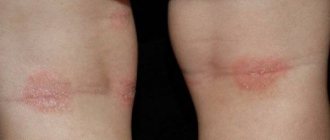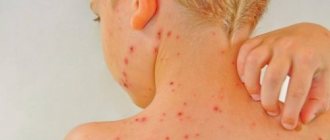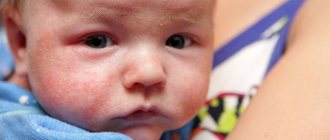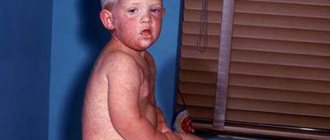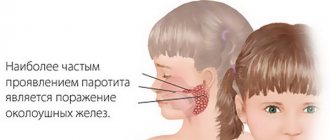Treatment
Seborrhea has a chronic course.
To correct the metabolic disorders that have arisen, complex therapy is required. It is possible to cure an exacerbation of seborrhea; for this you need to take into account all medical recommendations. Many parents believe that a visit to a doctor is not required to prescribe treatment, and they independently select a treatment regimen. This usually leads to an unstable positive result, which disappears fairly quickly. It is possible to treat seborrhea at home, but with mandatory supervision, which must be carried out by specialists. Dermatologists deal with problems associated with dermatological diseases. In some cases, additional tests and examinations are required before prescribing treatment. These diagnostic tests make it possible to exclude fungal or infectious skin pathologies that occur with the development of such symptoms.
If a child has concomitant chronic diseases of internal organs, these pathologies must be treated. Improving the appearance of the skin is impossible if there are functional disorders in the intestines or with an exacerbation of an endocrine disease.
Treatment for seborrhea includes:
Normalization of the daily routine. Excessive physical activity, which leads to severe fatigue, must be excluded from the child’s daily schedule. Night sleep is very important for restoring the nervous system. Its duration in children should be at least 8 hours. Very young children should definitely rest during the daytime.
- Dieting. All confectionery and sweets are significantly limited in the children's diet. The consumption of fatty foods should also be limited. These include various saturated fats, mayonnaise, lard, fatty pork and lamb, and goose pates. The child's meals should be fractional and include a sufficient amount of fermented milk products, fruits and vegetables.
- Taking multivitamin complexes. These medications must contain B vitamins. These biologically active substances have a beneficial effect on the skin, helping to normalize the functioning of the sebaceous glands. Some experts recommend taking them, which contain a fairly large amount of essential vitamins.
- Using gentle cosmetics. Shampoos containing antifungal ingredients help remove dandruff. If your hair is oily, you should not wash your hair too often. Frequent washing will only contribute to increased oiliness and will worsen the disease.
- Treatment of concomitant chronic diseases of internal organs. Prevention of exacerbations of these pathologies helps to improve the child’s overall well-being and reduce the manifestation of seborrhea.
- Consultations with a psychologist. Prescribed for fairly emotional children, as well as children who have suffered recent stress. Classes with a specialist lead to the normalization of nervous activity, which has a positive effect on the child’s well-being and appearance.
- Strengthening the immune system. Active physical exercise and proper nutrition have a positive effect on the functioning of the immune system. Strong immunity allows a child to quickly cope with various diseases. Daily walks in the fresh air have a positive effect on the appearance of the skin.
- Implementation of proper hygienic skin care. Recommendations regarding such treatment should be obtained from a dermatologist after a clinical examination of the skin. During such a study, the doctor will determine your skin type and also make individual recommendations for daily care of problem areas.
To see how it manifests itself, see the following video.
Symptoms of seborrheic dermatitis in children
Seborrheic dermatitis in a child is difficult to miss, especially if parents carefully monitor his behavior and appearance. When seborrhea occurs, you can find signs:
- Redness or swelling of certain areas of the skin,
- Peeling of the skin (dandruff is one of the most common types of dry seborrhea of the scalp),
- Oily shine, greasy hair. The very next day after washing, the hair looks greasy,
- Thinning or hair loss
- Severe itching. In a child, it can manifest itself in the form of moodiness, anxiety, restlessness, tearfulness,
- The appearance of dry yellowish crusts on the skin, which can be easily removed with a simple touch. Absolutely healthy skin is usually visible under the crusts.
Causes of seborrheic dermatitis
Seborrheic dermatitis occurs in those areas of the skin where there are many sebaceous glands: on the face (forehead, nose, chin), on the head, scalp, in the ear area, on the chest, back. Since a favorable environment for the development and activity of pathogenic microbes and fungi has been created, little remains to be done - it is necessary for the activity of microorganisms to increase. The fungus that causes seborrheic dermatitis is present on everyone's skin, but not everyone gets the disease.
In order for the fungus to begin its vigorous life activity, it needs the appropriate conditions:
- the patient has bad habits;
- malnutrition;
- genetic components of the sebum produced;
- hormonal changes.
Stress and disruptions in the functioning of the endocrine and immune systems contribute to the activation of fungal microflora. In addition to this, the pathological process is enhanced by such unfavorable factors as exposure to detergents and winter time. The human body is very sensitive to the effects of adverse factors and control over the proliferation of fungi is easily lost. As a result, the functions of the skin become disrupted and sebum production increases, which in turn contributes to the development of seborrheic dermatitis. If the patient has chronic infections (caries, tonsillitis, otitis media, sinusitis) or gastrointestinal diseases, then seborrheic dermatitis is difficult to treat.
Most often, seborrheic dermatitis occurs as a result of stressful situations, climate change, and excessive physical activity, which is a catalyst for its development. The risk of morbidity is much higher in those patients who had spinal pathologies, paresis, and paralysis. For example, seborrheic dermatitis always accompanies Parkinson's disease. If relatives suffered from eczema or seborrhea, then the risk of developing the disease becomes even higher.
Treatment
Seborrheic dermatitis in a baby does not require drug treatment for at least one year. In most cases, it goes away on its own after 4-6 months of independent living. Only in rare cases do crusty formations on the head and skin persist for up to 2-3 years.
Usually, it is quite enough to follow some hygienic and general rules that will allow the manifestation of such dermatitis to go away as soon as possible:
- Caps and caps are not needed at home. At least for a child with seborrheic dermatitis. You should put a cap or cap on your baby only when going outside, and you should dress your baby according to the weather, since excessive sweating provokes the growth of fungi. From the same point of view, you should reconsider the air temperature in the room. It should be no higher than 20 degrees Celsius. In this climate, sweating is significantly reduced.
- For bathing you only need children's cosmetics. Do not wash your baby with shampoos and foams. It is enough if parents use the most common baby soap to wash their hair once a week. Excessive use of even hypoallergenic soap created specifically for children also disrupts the function of the sebaceous glands.
Getting rid of seborrheic crusts is quite simple. If the damage is extensive and causes a lot of anxiety (for the mother, but not for the baby!), then you can use special antifungal shampoos. These are the well-known Nizoral shampoo and Sebulex.
It is better to start treatment of the scalp by softening the crusts. For this, grandmothers used heated sunflower oil. Today it is used, and Vaseline oil, and baby cream. After lubrication, you should wait about 15-20 minutes, carefully comb out all the crusts with a comb or a special brush for the head (the soft ones can be easily and painlessly removed), and then wash the child’s hair with shampoo with antifungal activity.
It is enough to do this once a week. More frequent washing and combing damages delicate skin. It is useful to complete water procedures by lubricating the areas that are free from crusts, “” or “La-Cri”, with products that moderately dry the inflamed areas of the skin, where necessary, and moisturize where the skin is excessively dry. Recently, the Emolium cosmetics line has gained great popularity. For babies in this line you can choose a good moisturizing cream and baby moisturizing soap.
If the rash spreads to areas of the body, and the baby shows anxiety when touching it, then ointments based on hydrocortisone or clotrimazole may be prescribed. If, during the formation of crusts or inept attempts to remove them, a secondary bacterial infection occurs, antibiotic ointments may be prescribed.
Following the rules for treating seborrheic crusts will help to avoid complications. They consist in a strict algorithm of parental actions:
- moisturizing and softening crusts;
- combing out soft crusts;
- the washing up;
- treatment with moisturizing or drying creams, and if prescribed by a doctor - with medicine.
It is strictly forbidden to touch dry crusts or try to eliminate them mechanically; this leads to injury to the skin and the addition of a secondary infection. Among folk remedies, pediatricians do not object to adding a decoction of chamomile, oak bark and string to bathing water.
Treatment with moisturizers
The following medications will help get rid of crusts on the baby’s head and skin:
- Cleansing oils . You can gradually soften dry lesions on the skin of a newborn with peach, olive or almond oil. The product should be warmed up before application. Apply the product once a day, before night swimming.
that have a therapeutic effect. To remove crusts, apply the product to dry skin 1-2 times a day. There is no need to wash off the cream. Therapeutic creams normalize the functioning of the sebaceous glands and eliminate pathology due to their antimicrobial effect. These drugs can be used to treat dermatitis on the cheeks, face and behind the ears.
Dermatological creams- Cleansers . Before going to bed, you need to apply a hypoallergenic cleanser to the affected areas, and then rinse thoroughly in the morning. Using this method of treating seborrheic dermatitis, you can get rid of crusts while washing your hair. Cleansers will help normalize the functioning of the sebaceous glands and prevent the re-development of pathology.
- Special shampoos . The selected product should be applied to damp hair, foaming thoroughly. Leave it on your head for 5 minutes and then rinse thoroughly with water.
The above products are sold at any pharmacy, but you can use them only after consultation with a dermatologist. The preparations must be applied no more than 2 times a week for 1.5 months.
Features of treatment
Treatment of seborrheic dermatitis of any type in children and adolescents is carried out through the use of medications, special shampoos and proven folk remedies. Additionally, diet therapy is carried out and personal hygiene rules are strictly observed.
Drug therapy
Drug therapy includes treating the skin with antifungal ointments and creams that can not only eliminate the symptoms of seborrhea, but also destroy the causative agent of the disease. Several popular drugs have shown themselves to be effective in treating dermatitis:
- Lamisil.
- Clotrimazole.
- Elidel.
- Losterine.
- Fenistil.
Important! If necessary, the patient may be prescribed sedatives, vitamin complexes, biogenic stimulants or restorative drugs.
Baby shampoos
Antifungal shampoos are also used to treat children over 5 years of age, which can be purchased at any pharmacy. Many dermatologists call the best remedies:
- Dermatozol.
- Skin cap.
- Keto Plus.
Folk remedies and recipes
You can treat seborrheic dermatitis at home using alternative medicine recipes. To prepare medicinal solutions, herbs and plants are used - fresh or dried.
You should use one of the following options:
- treat the affected areas with aloe juice diluted with water;
- add a decoction of oak bark, chamomile or string to the bathing water;
- Apply warm infusion of calendula to the affected areas.
Diet
Along with prescribing medications, the dermatologist will give nutritional recommendations and develop a therapeutic diet for the little patient, which is based on the consumption of foods high in vitamins A, C and B.
To effectively combat seborrhea, the basis of a child’s daily diet should be:
- lean meats or fish;
- fresh vegetables and fruits;
- greenery;
- dairy products;
- chicken eggs;
- dishes with gelatin;
- vegetable oils;
- Rye bread.
Personal hygiene
A key role in the treatment of seborrheic dermatitis is played by following the rules of personal hygiene, which can relieve the manifestations of the disease and prevent its recurrence. To ensure that recovery does not have to wait long, you should:
teach your child how to wash their hair correctly; do not use shampoos and gels intended for adults; do not use other people’s towels and personal hygiene items; Carefully remove crusts from the skin without scratching the areas of inflammation.
Diagnosis of seborrheic dermatitis
Symptoms in the form of redness, peeling, weeping, and certain locations of skin lesions may indicate a disease such as seborrheic dermatitis. Only after examining the patient will an experienced doctor receive a lot of information about the developed disease. However, in order to correctly establish a diagnosis, it is necessary to exclude similar skin diseases such as eczematid, atopic dermatitis, ringworm, psoriasis, and microbial infection. This can confirm or refute microscopic examination of skin scales for pathogenic fungal microflora. In some cases, a diagnostic biopsy of scales and crusts is prescribed, in which neutrophil cells are determined. If necessary, additional studies of the patient's hormonal status are performed.
Before visiting a doctor, you should not use cosmetics or take medications. Cosmetics will interfere with a full examination, and medications will weaken the manifestations and lead to a distortion of the clinical picture.
If the process of skin damage by seborrheic dermatitis proceeds for a long time, without treatment, it can ultimately lead to damage to large areas of the skin - erythroderma.
Symptoms
Seborrhea can be divided into two main types: dry and oily. Although they are considered parts of the same pathology, their symptoms can vary greatly. Therefore, we will analyze them separately.
So, the symptoms of oily seborrhea:
- Sticky, yellowish, large scales. They are difficult to separate from the skin. These particles resemble dough or paste in consistency. The tactile sensations when touching them with your hands are extremely unpleasant.
- Hair gets dirty very quickly and becomes covered with dust. At the roots they stick together into one bunch, at the ends, on the contrary, they separate.
- Mild itching may occur.
- The pores expand significantly.
- The sebaceous secretion loses its antiseptic properties, which causes acne.
- The amount of dandruff is small to medium.
Find out what to do if scabs appear on your head, as well as if your hair starts to fall out?
Symptoms of dry seborrhea:
- The skin dries out, cracks, and microtraumas occur on it. This is accompanied by severe itching.
- Hair becomes dry and brittle; due to weakening of hair follicles and drying of the skin, the process of hair loss begins.
- A lot of dandruff is formed. Peeling of the scalp leads to abundant “precipitation” in the form of white and yellow flakes.
- Layers are removed very easily.
- Large red spots appear - seboroids.
What to do if there is a lot of dandruff, dry skin and severe itching?
Typically, the dry form of the disease occurs during the development of the oily form. This is due to the fact that excessive sebum secretion leads to acne, infection, clogging of pores with layered scales and, as a result, a sharp decrease in the secretion of fluid by the glands.
On a note! Is seborrhea contagious or not and how is seborrhea transmitted? This is not a contagious disease. Despite the fact that it is caused by a fungus, which can indeed be transmitted from person to person, the main factor in the disturbance of sebaceous secretion is not the fungus itself, but the hormonal, immune and other factors that accompany it.
How to remove crusts on a baby's head
Many mothers unknowingly try to tear off dry scabs, which is strictly forbidden to do, because underneath there is delicate, unprotected skin that can be damaged from rough impact. It is better to purchase a specialized remedy for crusts on a baby’s head at a pharmacy or Vaseline oil, after consulting with a pediatrician. If the growths do not cause discomfort to the child, they do not need to be removed.
We suggest you familiarize yourself with the appearance of light spots on the skin
In most pharmacies today you can easily buy shampoo for newborns against seborrheic crusts. It helps soften unpleasant formations during bathing and remove them without harming the baby's delicate skin. You cannot use products intended for adults, because a child has a completely different hormonal profile, and the skin is more sensitive to the effects of the components.
If you decide to follow the advice of grandmothers and comb out the growths, remember to be careful. Any mechanical impact can lead to injury, so a comb for combing out crusts in infants should be made of natural soft bristles
She will carefully remove the scales without affecting the delicate skin underneath. You will have to be patient, because it is unlikely that you will be able to remove the crusts in one go.
As an aid, you can use cleansing oil to remove seborrheic crusts. It is applied to the affected areas, easily softens the scales, and helps remove them. To make the product work better, you can put a fabric cap on your baby, this will also help to avoid greasy stains on the pillow. After using the oil, you just need to wash your hair with shampoo.
Traditional treatment
In addition to traditional methods, after agreement with your doctor, you can use traditional medicine recipes at home.
Let's look at a few recipes that have been tested over the years:
Onion peel decoction
Ingredients:
- Dry onion peel - 50g.
- Water – 2 glasses.
How to prepare: cover the husks with water and boil for 20 minutes over low heat. Then leave covered for about an hour.
How to use: lubricate the scalp with the decoction 4-5 times a day.
Result: the decoction eliminates itching and reduces flaking.
Oak bark decoction
Ingredients:
- Oak bark – 5 tbsp.
- Water – 2 glasses.
How to prepare: cover the bark with water, boil over low heat for 15 minutes. Then strain.
How to use: rub into hair roots once a day, daily. Wash off after 40 minutes.
Result: the decoction strengthens the hair roots and eliminates pathogenic microflora.
Honey-egg mask
Ingredients:
- Onion juice – 1 tbsp.
- Honey – 1 tbsp.
- Castor oil – 1 tbsp.
- Egg yolk – 1 pc.
How to prepare: mix onion juice, honey and castor oil. Then add the egg yolk to the resulting mixture and mix well until a homogeneous mass is formed.
How to use: Apply the mask to the scalp and wrap with a towel. After 1.5-2 hours, wash your hair and hair thoroughly. Repeat the procedure 2 times a week.
Result: the mask improves hair condition, eliminates itching and dandruff.
Herbal decoction
Ingredients:
- Chopped sage – 1 tbsp.
- Water – 1 glass.
- Honey – 1 tbsp.
How to prepare: Pour boiling water over sage. When the broth has cooled a little, add honey. Mix well and strain.
How to use: Wipe skin 3-4 times daily.
Result: the product eliminates the manifestations of dry seborrheic dermatitis - itching, flaking, dry skin.
St. John's wort infusion
Ingredients:
- Chopped St. John's wort - 3 tbsp.
- Alcohol – 2 glasses.
How to prepare: pour St. John's wort with alcohol. Cover with a lid and leave for a week out of reach of the sun.
How to use: before use, dilute the tincture with water in a 1:1 ratio. Wipe your scalp every morning.
Result: the infusion copes with the signs of the oily form of seborrhea - eliminates flaking, reduces the intensity of sebum formation.
Review of main remedies against seborrhea
Seborrheic dermatitis, diagnosed in infants, tends to quickly disappear if special antifungal shampoos are used:
- Nizoral. The drug contains an antifungal substance - ketoconazole. With its help you can eliminate peeling and itching. Shampoo is used to treat seborrhea 2 times a week. The course of therapy will be a month, and prophylaxis - once every 30 days. Nizoral is used to wash the hair of children from birth. Substitutes: Sebozol, Ionel, Dermazol.
- Skin Cap. The drug is based on zinc pyrithione. It has an antifungal and antibacterial effect, and also eliminates the processes of cell division. When using shampoo, itching and flaking are eliminated, and the development of infectious complications is prevented. The drug is indicated for children over 1 year of age. The course of therapy will be 2 weeks. Substitutes: Friederm Zinc.
- Cynovitis. It contains components such as zinc pyrithione, dexpanthenol, urea and climbazole. The effect of the drug is to eliminate the inflammatory process. Its components have antibacterial and antifungal effects. The composition moisturizes the skin, removes dead cells, and starts the process of tissue restoration. You need to apply shampoo 2 times a week, the course of therapy is 30 days. You can use the product as a preventive measure for seborrhea - once a month. The use of shampoo is recommended for the treatment of oily and dry forms of seborrhea in children over 1 year of age.
Seborrheic dermatitis in infants is not a terrible disease, but it is still necessary to treat it. Pathology can occur for various reasons. But parents must be sure to eliminate crusts using moisturizers and mechanical methods. As soon as the digestive system and hormonal levels are normalized, the peeling will go away on its own. If dermatitis occurs in older children, then parents are obliged to seek help from a specialist who will prescribe an effective treatment regimen and determine the root cause of the pathology.
Views:1344
.
Differences between scaly lichen and seborrheic eczema
The symptoms of both diseases have many of the same signs, which leads to erroneous attempts at treatment at home. In psoriasis and seborrhea, obsessive itching, hyperemia of the skin, and the formation of scales are observed. The structure of education differs:
- with dermatitis, pathological lesions have a yellowish or grayish tint;
- silver color refers to the clinical symptoms of lichen planus;
- seborrheic dermatitis appears under the hair, psoriasis affects the knees, elbows, and chest.
Squamous lichen is provoked by impaired functionality of the liver, pancreas or stomach. Seborrhea is a dermatological abnormality. Patients are not carriers of the disease - these diseases are not transmitted.
Seborrheic dermatitis in children can occur for a number of reasons that need to be determined. Only after eliminating provoking factors can a complete recovery be achieved. Dermatologists emphasize that most attempts at self-medication do not lead to the expected effect, but aggravate the course of the disease. When the first symptomatic signs appear, the child should be taken to a local doctor for consultation.
A diagnostic examination will allow us to determine the type of pathogen that has penetrated and select appropriate medications. To avoid the development of complications, you do not need to wait for self-healing - this type of disease does not go away on its own.
Causes of seborrhea in children
Seborrhea can appear in a child at any age, and the reasons for newborns and, for example, adolescents will be different. Often the occurrence of seborrhea is associated with the state of health of the child.
Causes of seborrhea in newborns:
- Sweating.
Young mothers who have given birth to their first child are often too anxious about the health of their child. They put warm overalls on him, even if the air temperature in the apartment is optimal.
- Improper nutrition of the breastfeeding mother or the child herself.
Excessive consumption of fatty foods has a great impact on the functioning of the sebaceous glands. - Consumption of cosmetics and shower products with allergenic additives (strawberries, wild strawberries, cocoa, chocolate, etc.).
Various hygiene products for children are often made using berries, fruits and other products that can give a sweetish aroma, but not all of them are safe.
In adolescent children (12-15 years old), hormonal levels are unstable, which can also trigger the appearance of seborrhea.
Improper functioning of the glands in this case will be caused by:
- Puberty.
During this period, the secretion of glands increases, as the vegetative-endocrine system of the body is rebuilt. In this case, physiological seborrhea occurs in the child, which can end on its own by adolescence (15-20 years). - Congenital hormonal disorders.
In children, insufficient or, conversely, excessive production of hormones can affect the development of various endocrine, skin and other diseases, including dermatitis. - Lack of vitamin H (biotin).
This vitamin is also called the “beauty vitamin.” Due to the large amount of sulfur in the composition, it has a positive effect on the skin, hair and nails, and also participates in the metabolism of fats in skin and hair cells.Biotin deficiency often leads to seborrhea and hair loss.
- Long-term use of certain medications.
Anabolic steroids and testosterone, which boys can take in adolescence, negatively affect the functioning of the sebaceous glands. In girls, seborrhea occurs with excessive use of progesterone and some other hormonal agents.
- Diseases:
- lethargic encephalitis (“sleeping sickness”);
Itsenko-Cushing's disease (neuroendocrine disease);
- Parkinson's disease (neurological disorder).
- Mental disorders:
- affective insanity;
- various infectious psychoses;
- epilepsy;
- schizophrenia.
- Hereditary factor. In some cases, the cause of seborrhea in a child is the presence of this problem in one of the parents.
Causes
Seborrhea is not the only designation of the disease. Such changes can also be called gneiss or milk crusts. But in both cases we are talking about the formation of yellow and greasy spots on the head of a newborn baby. The main reason for their appearance is increased activity of the sebaceous glands. The pathology is considered a physiological norm, and usually recedes within a year. Moreover, some infants have a lot of crusts, while others have a small amount. In addition, they can cover not only the scalp, but can also be traced on the face or behind the ears.
The following factors can affect the development of seborrheic dermatitis:
- Incorrectly selected nutrition for a nursing mother. The presence of fatty foods, spicy and salty foods in the diet has a bad effect on the quality of milk, as a result of which the baby’s sebaceous glands begin to actively function.
- Overheat. It has been proven that in the hot season the number of seborrheic crusts in a child increases, so parents should not wrap him up too much.
- Poor hygiene and use of cosmetics unsuitable for infants.
- Increased proliferation of yeast-like fungi Malassezia furfur. This occurs due to poor hygiene, metabolic disorders, or as a result of stress.
- Introduction of complementary foods. The formation of crusts may indicate an allergy to the introduced product, so you will have to give up the new dish for a while.
- The use of antibiotics or medications that promote dysbiosis.
Why does seborrhea appear?
The main reason for the appearance of seborrheic dermatitis on the face or head of a baby is a fungus that feeds on sebum. It quickly responds to all processes in the child’s body that create favorable conditions for the proliferation and spread of fungus.
The disease can appear if the child is not properly cared for. For example, the baby spends a long time in a stuffy and dusty room, or is rarely bathed. Incorrectly selected baby hygiene products also cause seborrhea.
In children older than 1 month, seborrhea can develop as a result of the mother's allergies to foods or medications. Mom should exclude fatty, smoked and fried foods from her diet, as consuming them can cause disruptions in the child’s sebaceous glands.
Important! If seborrheic dermatitis in an infant is not treated, then after a year in the child it can develop into a chronic form, which is characterized by the appearance of itching and sebaceous crusts instead of dry ones. The first sign of this disease in infants is the appearance of common dandruff.
The first sign of this disease in infants is the appearance of ordinary dandruff.
The formation of crusts may be accompanied by hair loss. The disease usually appears towards the end of the first month of a baby's life. A distinctive feature of seborrheic dermatitis in infants is the absence of itching.
Note. The disease can occur in mild, moderate or severe form. The latter is characterized by the appearance of the following symptoms: lethargy, general malaise, sleep disturbance, vomiting, indigestion.
At the initial stage, only red spots appear, which begin to peel off over time.
Before starting self-treatment, you should visit your local pediatrician, who will refer the child to a dermatologist. The dermatologist prescribes tests, based on the results of which he determines the course of necessary treatment.
Treatment of seborrhea on the head
An effective treatment for seborrheic dermatitis in infants is thorough washing of the hair using a special shampoo. It can be done two to three times a week. The entire course is usually 1.5 months. After washing their hair, parents need to remove the scales with a brush or tweezers.
Important! Under no circumstances should scales be removed or torn off by hand. These actions can damage the skin and cause infection.
You need to carefully comb out the softened scales after washing your child’s hair. Seborrheic dermatitis in infants can also be treated using home remedies.
You need to apply olive or baby oil with vitamin E or Vaseline to the child’s head, then put on a cap for 20 minutes. Wash your hair with warm running water using baby shampoo. Afterwards you need to comb out the crusts with a brush.
Seborrheic dermatitis in infants can also be treated using home remedies. You need to apply olive or baby oil with vitamin E or Vaseline to the child’s head, then put on a cap for 20 minutes. Wash your hair with warm running water using baby shampoo. Afterwards you need to comb out the crusts with a brush.
After water procedures, a drying cream should be applied to the baby’s scalp. If such creams do not have an effect, then the doctor may prescribe antifungal ointments.
Treatment of seborrhea on the face and body
If the rash has spread to other parts of the body, then while bathing you can use a special gel-foam for the shower, and then wipe the skin with a special cleansing gel (Topicrem, Saforel).
When treating seborrheic dermatitis on the face of a baby, you should limit skin contact with water and use products that do not irritate the skin. The baby's face can be treated with Tsindol or an antifungal agent (as recommended by a doctor).
Important! Before using any product to treat seborrhea, you should definitely consult your doctor. As a concomitant treatment, the doctor may prescribe the drug Aevit or a body cream based on vitamin A
It will help maintain skin elasticity and help stop flaking. If the disease is complicated by infection, then antibiotic therapy is prescribed
As a concomitant treatment, the doctor may prescribe the drug Aevit or a body cream based on vitamin A. It will help maintain skin elasticity and help stop peeling. If the disease is complicated by infection, then antibiotic therapy is prescribed.
There are several simple rules that will help avoid the appearance of seborrheic dermatitis in infants:
Symptoms
Seborrheic dermatitis in infants is recognized by the following symptoms:
- redness;
- peeling, formation of dry crusts and dandruff on the head;
- yellow crusts on the skin;
- merging of individual areas into extensive foci.
A distinctive feature of seborrhea from other skin pathologies is the absence of itching.
According to clinical manifestations, seborrheic dermatitis is usually divided into 3 types:
- Dry seborrhea . Due to insufficient sebum production, the dermis is covered with dry scales, and dandruff forms on the head.
- Fat . With the active production of sebaceous secretions, fatty yellow crusts form on the skin of the head and face.
- Mixed . Dry seborrhea is observed on the head, and oily seborrhea on the dermis.
In newborns, the oily form of seborrheic dermatitis is most often diagnosed.
If the disease was caused by a hormonal imbalance, then it goes away on its own without causing much concern.
Inflammation that occurs against the background of other diseases or is associated with a hereditary predisposition is more difficult to treat, it becomes chronic and sometimes there are periods of exacerbation.
Inflammatory seborrhea
Otherwise it is called seborrheic eczema. It begins with the appearance on the scalp of clearly defined red spots, the surface of which is covered with small white scales. The skin becomes dry and thin and looks tight. Gradually, the scales are glued together by sebum and become large and yellow-green in color. They are tightly fused to the skin; after their removal, a moist area of bright red color remains.
The source of inflammation spreads to the periphery, and the skin in the center gradually gets rid of peeling and takes on its normal appearance. Along the edge, eczema is outlined by a bright red rim, which can rise above the skin due to swelling. Gradually, the lesion descends from the scalp onto the face and this red border looks like a rim - a “seborrheic crown”.
Eczema itself does not cause severe itching and weeping, but as soon as pathogenic microflora joins, the inflammatory phenomena sharply intensify. Pustules and ulcers appear, the surface of the spot becomes moist and very itchy. This severe course is observed in persons with immunodeficiency.
In people suffering from liquid seborrhea, seborrheic eczema looks slightly different; it is also called Unna disease. It begins with a rash of small yellow nodules on the skin, the surface of which is flaky and covered with greasy scales. Gradually they stick together and form round plaques up to several cm in diameter.
Shampoo for seborrheic dermatitis easily cures eczema, but it is prone to relapse.
This is one of the types of the disease - seborrheic dermatitis in infants. Immediately after birth or during the first six months of life, dense yellow-gray smooth scales appear on the baby’s head. They can merge with each other and reach sizes up to 0.5-0.8 cm. The scales are tightly fused to the skin; after removal, thinned pink skin remains underneath them
This should be done very carefully, only after soaking and soaking in oil. Otherwise, pathogenic microbes will penetrate into areas of skin damage, which will lead to the formation of pustules and blisters.
Seborrheic dermatitis in infants is regarded as an adaptation of the skin to new living conditions. As a rule, it occurs in children prone to allergic reactions. They are often bothered by atopic dermatitis in the first years of life. There is scientific evidence that such disturbances in the functioning of the baby’s immune system are caused by the mother’s nervous stress during pregnancy.
Before treating seborrheic dermatitis in a child, be sure to consult a dermatologist and pediatrician.
Read about dandruff in children.
